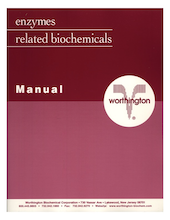Enzyme Manual
The Worthington Enzyme Manual contains technical information on enzymes including molecular weight, composition, activators, specificity, inhibitors, stability, assay method, optimum pH, ionic effects, temperature effects, extinction coefficient, and isoelectric point, as well as applications and extensive references.

The histones are a group of water and dilute acid soluble basic proteins found associated with DNA in chromosomes. They are characterized by relatively high levels of lysine and arginine. Although…
The hyaluronic acids (HA) are a class of macromolecular proteoglycans characterized by a highly polymerized chain of glucuronic acid and N-acetylglucosamine units bonded to protein. They exist in…
Hyaluronidase catalyzes the random hydrolysis of 1,4-linkages between 2-acetamido-2-deoxy-b-D-glucose and D-glucose residues in hyaluronate.
Characteristics of Hyaluronidase from Bovine Testes:
Hydroxysteroid dehydrogenases catalyze the interconversion of hydroxyl and carboxyl groups of steroids. Those from Pseudomonas testosteroni are of two types:
1. 3α-Hydroxysteroid Dehydrogenase (1.1.…
Lactate dehydrogenase (LDH) catalyzes the following reaction:
Human LDH has been reported on by Ringoir and Plum (1975), Emes et al. (1974), Markel and Janich (1974), McQueen (1974), Burd and…
L-lactic acid dehydrogenase from baker's yeast (cytochrome b2), in nature, catalyzes the following reaction:
Other known oxidants which can be used in vitro are ferricyanide, phenozine…
Lactoperoxidase (LPO) catalyzes the hydrogen peroxide oxidation of iodide.
The bovine milk enzyme is identical to that formed in bovine lacrimal and salivary glands (Morrison et al. 1965; and…
Leucine aminopeptidase (LAP) is an exopeptidase that catalyzes the hydrolysis of amino acid residues from the amino terminus of polypeptide chains. LAPs are widely distributed, ubiquitous in nature,…
Pancreatic lipase (PL),one of the exocrine enzymes of pancreatic juice, catalyzes the hydrolysis of emulsified esters of glycerol and long chain fatty acids. The substrate is not a single molecule…
Bacterial luciferase (LU) catalyzes the oxidation of reduced flavin mononucleotide (FMNH2) and a long chain aldehyde by molecular oxygen to yield FMN, the corresponding acid, H2O and light. (Baldwin…
Lysozyme is an antimicrobial enzyme that is found in a wide variety of organisms including birds, mammals, plants, insects, and bacteria (Newman et al. 1974). The lysozyme of chicken egg white has…
Malate dehydrogenase (MDH) catalyzes the interconversion of L-malate and oxaloacetate using nicotinamide adenine dinucleotide (NAD) as a coenzyme.
MDH is found in all eukaryotic cells as two…
α-Glucosidase (Maltase) hydrolyzes the terminal, non-reducing 1,4-linked α-D-glucose residues with release of α-D-glucose. α 1,2 and α 1,3 bonds are cleaved at a much slower rate. The rate of…
These are dried cells suitable as a lysozyme substrate. Lysozyme preferentially hydrolyzes the b-1,4 glycosidic linkages between N-acetylmuramic acid and N-acetylglucosamine which occur in the…
Mucins are the glycoproteins in epithelial mucous secretions; their protective function is due to their high viscosity. Svennerholm (1963) describes the preparation of sialic acids from mucin.…
Myoglobin (Mb) is a small, globular protein primarily responsible for oxygen storage in cardiac and skeletal muscle. Mb is involved in the regulation of cellular oxygen tension in respiring…
NADase catalyzes the following reaction:
The enzyme is found primarily in animal tissue. That from pig brain has been purified by Swislocki and Kaplan (1967). See also Kaplan (1955). Bernheimer…
Most traditional methods published for isolating neonatal cardiomyocytes utilize crude and partially purified enzyme preparations such as trypsin NF 1:250 (Gross, et al. 1968) and collagenase. More…
Neuraminidase (sialidase) splits off N-acetyl neuraminic acid (sialic acid) from a variety of glycoproteins.
Neuraminidases are important tools for the study of glycoproteins in protein chemistry…
Neutral protease is an extremely stable Zn-metalloendopeptidase that is produced by Paenibacillus polymyxa. It is involved in the generation of beta- and alpha-amylases from the large amylase…



